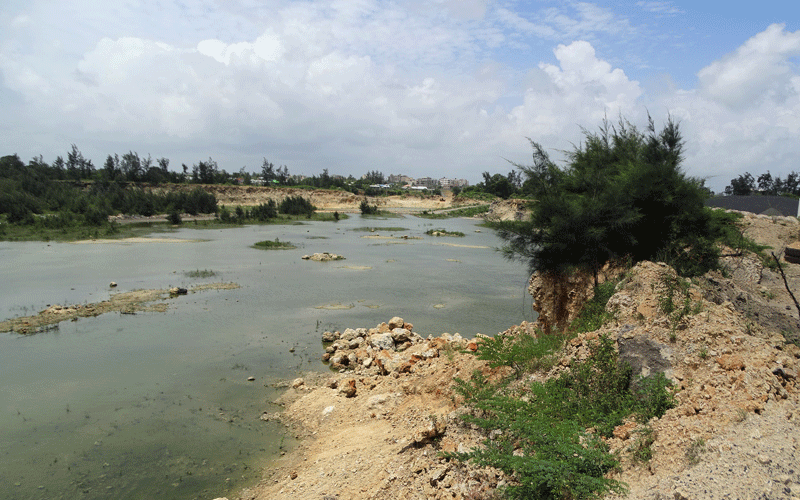Rescue efforts offer hope for endangered tortoise

Clifford Akumu
They’re pretty, naturally shy and harmless. And they are the stars of the pet trade. The rare Indian Star tortoise, scientifically known as Geochelone elegans, is one of the most rescued tortoise species in the world.
It is on the red data list of the International Union for Conservation of Nature (IUCN), the international body that sets conservation statuses for species around the world, rated as Vulnerable (VU).
And its illegal trade has skyrocketed. Now, conservationists and reptile experts are worried that if action is not taken to conserve it, it will lead to its extinction.
But it’s not all bad news. The species, with a beautifully patterned shells, has found signs of hope at a restored quarry ecosystem in Bamburi’s Haller Park at the Kenyan Coast in what conservationists pitch as “race against time to raise the species from the brink”.
“The star tortoise is highly sought particularly for pet trade. This has significantly worsened its distribution globally and equally created unpredictable pattern of its geography and even populations,” said Albert Musando, Environmental Education and Ecosystems Manager at Bamburi Lafarge Ecosystems.
Although the IUCN Red List and other sources do not provide the species total population size, “The numbers in the wild are quite staggering. What we are doing at Haller Park is part of corrective actions to avert the specie’s population collapse,” he explains. 
Scanty Data
The star tortoise can grow to about 12 inches long, with a lifespan of over 30 years, although it’s believed they can go up to 80 years.
They do not like being handled; the stress caused by frequent handling can affect their health.
It is generally crepuscular, meaning they are active in the early morning and the late afternoon during dry, hot weather. The rest of the time, they shelter under vegetation or some other cover.
There is scanty data on the population of star tortoise in the country since it is not native to Kenya. Indian star tortoises are found in India, Pakistan and Sri Lanka.
It is mostly kept as pets and breeding is not clearly established.
“At the Bamburi Haller Park, we only have one Indian star tortoise. Here, it serves the purpose of conservation education and awareness on their importance in an ecosystem,” Musando said.
But how did the species find its way into the conservation facility? Musando explains; “In late 1990’s an Indian family relocating from Kenya after many years of living in Mombasa brought us the star tortoise.”
Kenya Wildlife Service (KWS) and good Samaritans bring in most animals from different places for safekeeping and care. Just like other animals at the park, the Indian star tortoise was then put under special care, with close support and monitoring from KWS after which it is groomed to occupy the restored ecosystems.
And as an extension conservation initiative, explains the ecosystems manager. “We have been monitoring its care and health and trying to understand its interaction with other species at the park.”
But it is not only conservation that reigns here.The park also consists of a game sanctuary, reptile park, a demonstration fish farm, palm garden, crocodile pens and giraffe viewing platforms.
The rehabilitated ecosystem now offers refuge to some rare and endangered species.
The conservation of the rare species is critical in protecting and raising their numbers. But increased habitat loss, illegal collection for the international wildlife trade and the long reproductive cycles are grinding conservation efforts to a halt.
All of these factors reduce the capacity of populations to recover from human-induced effects on the population, he said.
Restoring indigenous coastal forests in the quarries, which were once ‘ugly scar on a beautiful environment’,to support conservation of local biodiversity is vital.
Global effort
“In essence, we are giving nature a helping hand,” Musando said.
Still, tortoises play important roles in the ecosystem making their conservation beneficial.
As herbivores, they feed on fresh vegetation: grass, fresh greens, thus define and impact their habitats through grazing on plants, dispersing plant seeds and trampling areas of vegetation-an important role in germinating seeds.
“Through feeding on ground vegetation, they thin out and open up new areas of ground for diverse vegetation to grow. They are also an important element in the food chain as birds of prey and carnivores feed of them thereby filling an important gap in the chain.
“It is unfortunate they have been reduced to pets or zoo animals in many parts of the world, and now there are efforts to change this.
“This is an effort to join global initiatives to protect, conserve, give them a chance and allow the future generations to experience interactions with the animals,” Musando explains.



